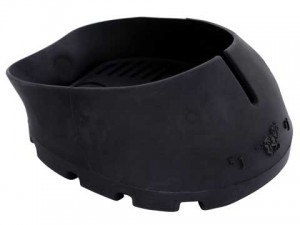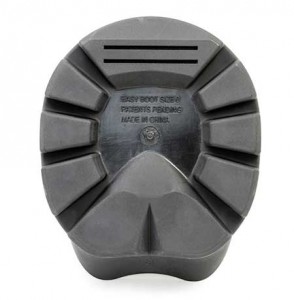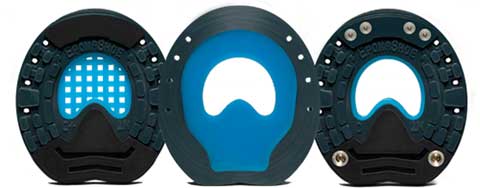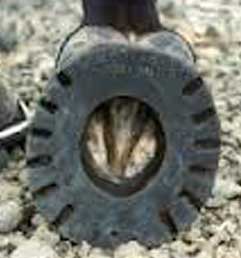New Take on Shoes
By Marsha Hayes May 19, 2013It used to be simple. Back in the day, kids went barefoot in the summer and if times were good, Dad bought everyone a new pair of shoes in the fall for school. It was simple for the horses, too. Old Dobbin went barefoot and if he seemed tender, an attractive, burly man appeared and nailed on four steel shoes and life trotted on.
Not so today. Horse owners and the horses face a myriad of choices when it comes to shoe shopping. Even the language has become complicated. Horses are today offered “hoof protection,” relegating the word “horseshoe” to that crescent-shaped steel thing the good looking burly man nailed on. Hoof protection now covers the many composite products meant to be strapped on, buckled tight, or glued on a well-trimmed hoof.
Whether or not to go barefoot we’ll leave to another article. Most owners that ride their horses regularly opt for hoof protection. We’ll look at some of the options available.
EasyCare’s Easyboots

The Easyboot Glue-On is a high performance option that was developed for endurance, but is suitable for other uses.
Because of the number of miles traveled and the varied terrain, it is natural that the sport of endurance became a proving ground for non-traditional hoof protection, and EasyCare Inc., maker of boots and now glue-on rubber shoes, is the undisputed market share leader when it comes to non-steel shoes in the endurance world. Since endurance riders are so sensitive to their horses’ health, and feet in particular, it’s often the first place to notice a paradigm shift. Kevin Myers, director of marketing for EasyCare, said that while the company uses endurance, in all its extremes, to “showcase” its product, “the backbone of our market is the trail rider.”
Across both sports, Myers said he’s observed that “the number of people willing to try alternative forms of hoof protection is definitely on the rise.” Both Myers and EasyCare president and CEO Garrett Ford compete in endurance at the high-performance level.
Theirs is a “boots on the ground” personal approach to the products they sell.
Ford won the 2012 Tevis Cup—California’s famous 100-miles-in-24-hours endurance race—on The Fury. The top four Tevis finishers this year all wore Easyboots, as did the Haggin Cup winner for Best Conditioned horse. Six of the top 10 used the company’s products.
“The last three horses to finish were also in Easyboots, so we’ve got things covered from all sides,” Myers laughs.
Easybooted horses had a 69% completion rate, compared to a 41% non-Easybooted horse completion rate.
In 2011, 37 horses started with glued on boot protection and 28 completed. But there were 177 starters, so even factoring in some other alternative brands, that’s still a large number of steel shoes!
In 2011 Jeremy Reynolds riding Riverwatch won the Tevis Cup with the help of Easyboots. (Although 2010’s winner, John Crandell, a farrier, is a fan of traditional steel shoes.)
The company offers 14 different types of boots, including the two newest brands: the Easyboot Trail (which touts easy on/off) and the Easyboot Glove Back Country (combining the features of the Trail with the flagship chassis of the Easyboot Glove).
An EasyCare glue-on shoe may come to market in 2013. “We are still playing around with the design,” Myers said, noting that the product is expected to appeal to the broader market of owners who currently use traditional steel shoes.
EponaShoes
EponaShoe president Monique Craig is passionate about hooves. A professional farrier for 15 years, as well as a painter, sculptor and engineer, she uses her multidiscipline background to reevaluate the traditional approach to shoeing. She founded the Paso Robles-based Epona Institute to explore the biomechanics of equine movement in general (and that of the foot in particular) and to develop alternatives in hoof protection.
“I look at my shoe as a hoof extension,” Craig explains. “It all starts with the hoof.” EponaShoes are a composite of three types of polyurethane, with two small steel stiffeners. The shoe is usually affixed with both nails and adhesive, but the owner has options to use only adhesive to customize the experience to a horse’s individual needs. Her shoes are popular among dressage riders (Steffen Peters used them on Ravel for a while) and have also been used in endurance.
Craig owns 12 horses, and uses them as her R&D lab. She is not afraid to admit that no matter how wonderful the shoe, it all starts with a great trim. But insofar as the EponaShoe’s specific benefits, she lauds their flexibility and ability to wear gently as solving some of the problems encountered with the domesticated equine. “As a horse lover, I am a problem solver,” she said.
“Different materials have different mechanical properties. You don’t want the shoes too soft, too hard, too grippy, too difficult to use. We need to try to keep things simple. As Einstein said, ‘Things should be as simple as possible, but not simpler.’”
Equithotics Sneaker
Some top endurance riders, including Valerie Kanavy and Janine Esler, endorse Equithotics, the “sneaker” for your horse. “They’re rubber against the ground, aluminum in the middle and rubber against the foot, so there’s all this super cushioning,” Esler said. “I have them on the horses that are training with me doing 50 miles or more.”
Esler cited several factors that make Equithotics her top choice. “There’s more surface area to support the foot, which means more surface area for the weight to come down on. They’re like a great, big, thick donut.
“A normal shoe goes halfway around the shoe and just around the rim of the foot. This one’s got a big wide rim that goes all the way around, with a big, wide heel. There’s a donut hole in the center, and you put in a nice, soft gel that supports the frog,” which, she noted, most people don’t realize can benefit from the right kind of support, too.
Equithotics are available through many farrier supply shops in the U.S. and internationally, and can also be ordered directly from the California-based company. While they are more expensive than metal shoes, Esler said she typically gets two or three resets from them in normal training. If a client can’t afford the full set, she recommends getting them in the front with metal shoes behind.
“My thought is if they’ll takes a lame horse and make ’em sound, they should be able to take a sound horse and keep them sound longer. And they do.”
A Farrier’s Perspective
Tom Trosin, president of the American Farriers Association, lives in Stratford, Oklahoma, but due to a continued California demand for his services, travels to Los Angeles every six weeks to shoe dressage horses, hunters, Arabians, Saddlebreds and even some geriatric pensioners. At age 14 Trosin started pulling shoes for his farrier father to streamline his dad’s work and he now has 28 years under his leather apron as a professional farrier. As president of the AFA he leads nearly 3,000 men and women farriers as they strive to increase both their own and horse owner’s educational level concerning hoof care.
Trosin’s advice for horse owners is to select a farrier who belongs to a farriers’ association. “Belonging to the association shows a farrier is not afraid to learn,” he explained. The association encourages continuing education. “Every month our members get something in the mail, or Emagazines,” Trosin points out. Horse owners can visit the association web page and search by location to find members and view their level of certification.
The association offers three levels of certification, each with a written test and two practical phases including the evaluation of such skills as hoof balancing and shoe building. AFAl tests throughout the country throughout the year. Shaped by his decades of experience, Trosin believes, “Association members are better farriers than they were 20 years ago. I see them giving more credence to what the owner’s concerns are. Our members are just more professional.”
Trosin is a strong advocate for the welfare of all horses. He bears no animosity towards the concept of hoof protection in a non-traditional form. “It doesn’t matter what you put on a horse’s hoof. What matters is if that hoof capsule is properly prepared.” The proper trimming to create balance and stability rests on the farrier or trimmer. Nailing on a shoe is only a part of a farrier’s duties. “An appliance, glued, strapped, velcroed on… it makes no difference. The question every horse owner should be asking is: ‘Were the hands that prepared the foot skilled enough?’”
Trosin recalled a hunter he shod that competed until he was 28 because the horse “could do it and would do it.” Traditional shoes were obviously a good choice for him, as well as the famed Elmer Bandit, national mileage record holder for the North American Trail Conference. Elmer Bandit, steel shod, carried owner Mary Anna Wood across the finish line to reach 20,720 lifetime competition miles and the national record on October 26, 2008. At the time Elmer was 37 years old. Elmer continued to compete, lightly, for two more years. Traditional steel shoes obviously worked for Elmer.
Short URL: https://theequestriannews.com/?p=14512







